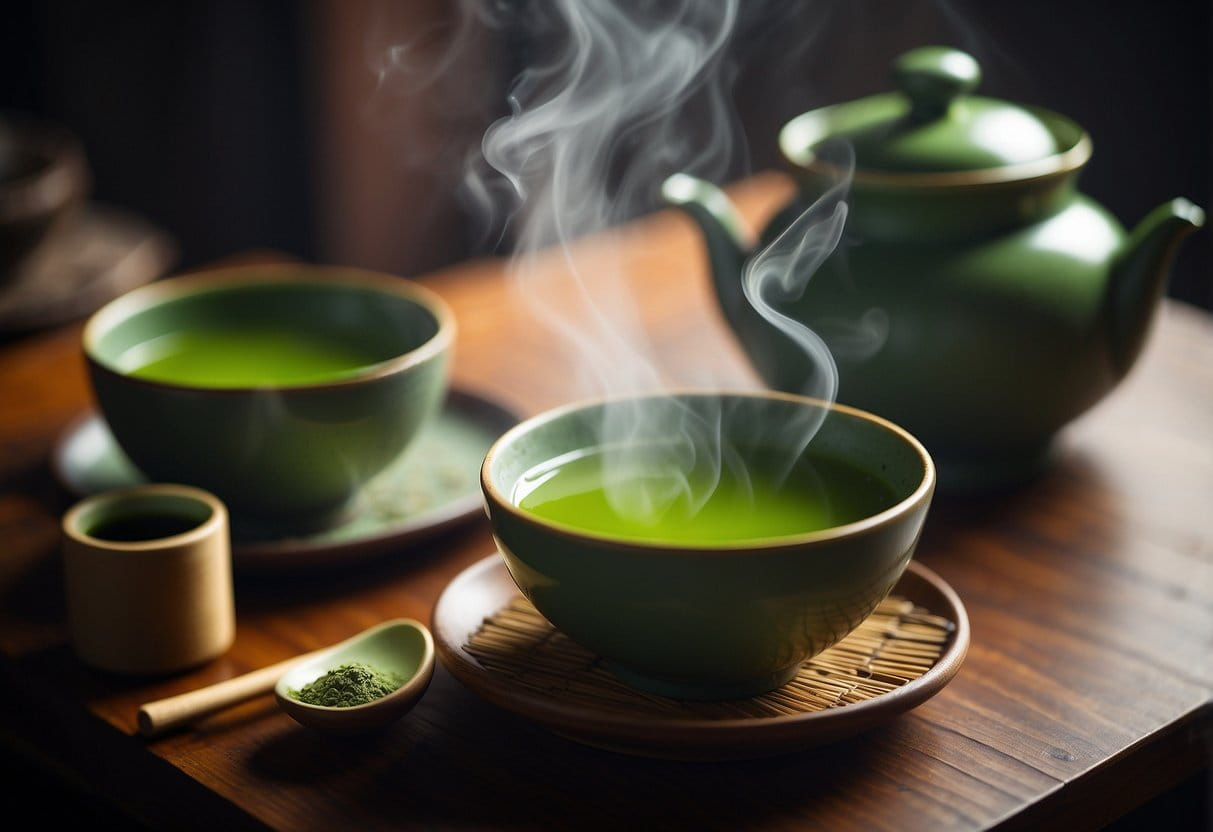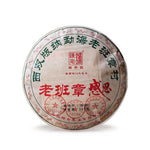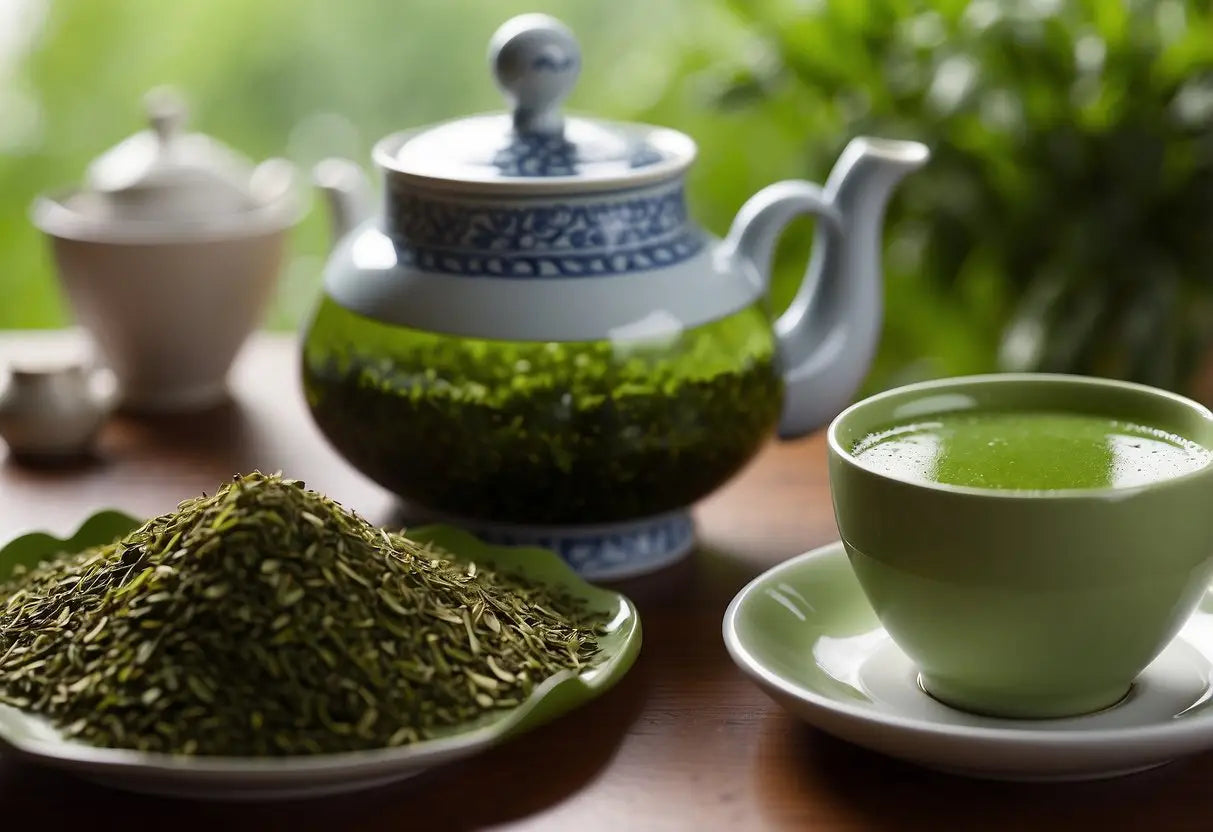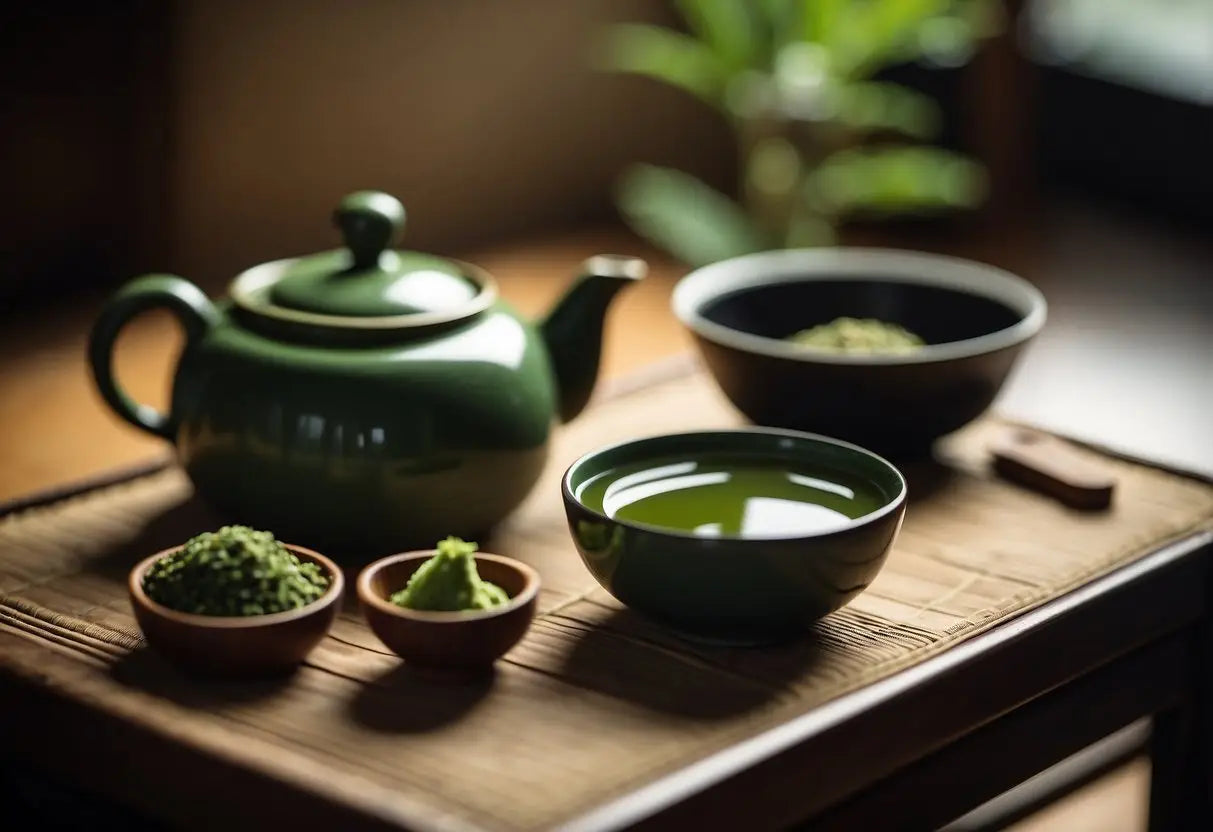Sencha vs Matcha
Sencha and Matcha are two popular types of Japanese green tea, each with distinct characteristics.
Sencha
Sencha is made from whole tea leaves, which are steamed, rolled, and dried. You typically brew Sencha by steeping the leaves in hot water.
- Appearance: Whole, rolled green leaves
- Flavor: Grassy, slightly sweet, sometimes astringent
- Caffeine: Moderate
- Preparation: Steeped
Matcha
Matcha is a powdered green tea made from shade-grown leaves. These leaves are deveined and destemmed before being stone-ground into a fine powder. You prepare Matcha by whisking the powder with hot water.
Bestsellers

2022 Pu-Erh Tea Sample Box (Free Shipping)

2022 Yi Pin Chen Sheng Raw Pu-erh Tea Sample Box

2022 Lao Ban Zhang Raw Pu-erh Tea

2022 Na Ka Raw Pu-erh Tea

2023 Ban Zhang Yin Xiang Raw Pu-erh Tea

2017 Rong Pu Ripe Pu-erh Tea
- Appearance: Fine green powder
- Flavor: Rich, creamy, umami
- Caffeine: High
- Preparation: Whisked
Nutritional Benefits
Both teas offer high levels of antioxidants, vitamins, and minerals, but they differ in how these nutrients are consumed.
- Sencha: Absorbed from steeped leaves
- Matcha: Consumed whole, more nutrient-dense
Uses
Sencha and Matcha are versatile and can be enjoyed in various forms beyond traditional tea drinking.
- Sencha: Hot or iced tea, cooking, baking
- Matcha: Lattes, smoothies, desserts
Understanding these key differences can help you decide which tea best suits your preferences and needs.
Origin and History

Both Sencha and Matcha have rich histories that date back centuries, originating from different cultural practices in Japan.
Sencha Origin
Sencha originated in Japan during the Edo period. It is produced by steaming, rolling, and drying tea leaves. This process enhances the flavor and preserves the vibrant green color. Sencha became popular when Zen priests promoted its health benefits and unique taste. It is grown in the Shizuoka region, which is known for its optimal climate for tea cultivation.
Matcha Origin
Matcha's roots can be traced back to the Tang Dynasty in China, but it was popularized in Japan by Zen Buddhist monks. The tea leaves are shaded before harvest, increasing chlorophyll and L-theanine content. This method produces a distinct, vibrant green powder. Matcha is traditionally used in Japanese tea ceremonies and has deep cultural significance.
Processing Techniques
The distinct processing methods of sencha and matcha result in unique flavors, textures, and culinary applications. You'll discover the precise stages that define each tea's journey from leaf to cup.
Sencha Processing
Sencha involves several key steps to preserve its fresh, grassy flavors and distinctive appearance. After harvesting, the leaves are quickly steamed to prevent oxidation and lock in the green color. The steaming process usually lasts between 15-20 seconds.
Following steaming, the leaves are cooled and then rolled into thin, needle-like shapes. Rolling helps release the tea's natural juices and enhance its aroma. Finally, the leaves are dried gradually, ensuring even moisture evaporation. This meticulous processing yields a vibrant green tea with a balanced flavor profile.
Matcha Processing
Matcha's processing emphasizes shading and meticulous grinding to create its unique powder form. A few weeks before harvest, tea bushes are covered to reduce sunlight exposure. This shading increases chlorophyll levels and enhances amino acids, giving matcha its rich, umami taste.
After harvesting, the leaves are steamed to prevent oxidation. The leaves are then dried and their stems and veins removed, resulting in pure leaf material called tencha. The tencha is ground into a fine powder using granite stone mills. This precise grinding process can take up to an hour for just 30 grams of matcha, producing a smooth, vibrant green powder perfect for traditional tea ceremonies and modern culinary uses.
Lao Ban Zhang

2024 Lao Ban Zhang Ripe Pu-erh Tea

2022 Lao Ban Zhang Raw Pu-erh Tea

2023 Ding Feng- Lao Ban Zhang Raw Pu-erh Tea (42g)

2024 Xiao Ban Zhang Raw Pu-erh Tea

2020 Lao Ban Zhang Raw Pu-erh Tea 125g

2025 Lao Ban Zhang -Gan En Raw Pu-erh Tea 357g
Flavor Profile
The flavor profiles of Sencha and Matcha teas are distinct and offer unique tasting experiences. You can expect subtle variations in sweetness, astringency, and overall complexity.
Sencha Flavor
Sencha tea presents a fresh, grassy flavor with a delicate balance of sweetness and astringency. The initial taste is often described as vegetal, akin to steamed greens, with a slight umami undertone.
When brewed at the right temperature, Sencha can also reveal a hint of nuttiness or marine notes. Depending on the specific variety and production method, you might notice subtle floral or fruity nuances.
Sencha's flavor can change significantly with brewing time and water temperature, emphasizing its complexity. Lower temperatures and shorter brewing times tend to enhance its sweetness, while higher temperatures and longer brewing times increase its astringency and bitterness.
Matcha Flavor
Matcha tea offers a rich, creamy flavor profile with pronounced umami. It is characterized by a bold, bittersweet taste that some describe as vegetal with a smooth, lingering aftertaste. The stone-ground powdered form of Matcha allows for a full-bodied experience, as you consume the entire leaf.
The creamy texture often contributes to a rich mouthfeel. Quality Matcha can also exhibit slight sweetness and hints of natural sweetness, contrasting with its inherent bitterness.
Preparation techniques such as sifting and whisking affect the final flavor, emphasizing its refined and sophisticated nature. Using lower grade Matcha may result in a more pronounced bitterness, whereas higher grades provide a sweeter, more harmonious taste.
Health Benefits

Sencha and Matcha both have significant health benefits, attributable to their high antioxidant content, vitamins, and other nutrients. While they come from the same plant, the different processing methods result in distinct nutritional profiles and health benefits.
Sencha Health Benefits
Sencha, a popular type of green tea, is rich in catechins, particularly epigallocatechin gallate (EGCG), which is known for its antioxidant properties. These antioxidants help to fight free radicals, potentially reducing the risk of various chronic diseases.
Regular consumption of Sencha can improve cardiovascular health by lowering LDL cholesterol levels and improving blood flow. Additionally, Sencha is known to aid in weight loss by boosting metabolism.
Sencha also contains Vitamin C, which supports the immune system, and L-theanine, an amino acid that promotes relaxation without drowsiness. This combination of nutrients can provide a calming yet alert state of mind.
Matcha Health Benefits
Matcha contains the entire tea leaf, making it richer in nutrients compared to regular green tea. This results in higher concentrations of antioxidants, including EGCG. Matcha is known for its ability to enhance cognitive function and concentration due to its significant L-theanine content.
Because you consume the whole leaf when drinking Matcha, you benefit from higher levels of fiber and chlorophyll. Chlorophyll is believed to help detoxify the body. The high fiber content aids in digestion and may contribute to prolonged satiety, which can be beneficial for weight management.
Moreover, Matcha is packed with vitamins such as Vitamin A, which supports eye health, and Vitamin C. The mixture of these vitamins and antioxidants sharpens your immune defense and enhances your overall well-being.
Caffeine Content
When comparing Sencha and Matcha, caffeine content is a crucial factor.
Sencha:
Sencha is a type of green tea where the leaves are steeped in hot water.
Typically, an 8-ounce cup of Sencha contains about 20-30 milligrams of caffeine.
Matcha:
Matcha is powdered green tea made by grinding whole tea leaves.
An 8-ounce serving of Matcha can have up to 70 milligrams of caffeine.
Since you consume the entire leaf, the caffeine is more concentrated.
In table form:
| Tea Type | Caffeine Content (per 8 oz) |
|---|---|
| Sencha | 20-30 mg |
| Matcha | Up to 70 mg |
Due to the differences in preparation, caffeine absorption also varies.
Sencha provides a more gradual caffeine release.
Matcha delivers a quicker, more pronounced boost in energy.
If caffeine sensitivity is a concern, you might prefer Sencha for its lower caffeine levels.
Matcha is ideal if you need a more substantial caffeine impact.
Culinary Uses
Sencha and matcha both have unique applications in the culinary world, with sencha commonly used in beverages and matcha often incorporated into both sweet and savory dishes.
Sencha Uses
Sencha is primarily used to brew tea. The leaves are steeped in hot water to create a refreshing drink with a light, grassy flavor. You can enjoy it hot or cold.
Additionally, sencha's brewed leaves can be incorporated into recipes. For example, you might mix them into a light salad or use them to flavor soups. Another popular use is in making traditional Japanese tea blends, combining sencha with other herbs and ingredients for unique flavors.
Lastly, sencha is sometimes used in dessert recipes, such as green tea ice cream or cakes. Its subtle taste pairs well with slightly sweet and creamy profiles, adding a unique twist to classic treats.
Matcha Uses
Matcha has a wide variety of culinary applications due to its powdered form. One of the most popular uses is in tea ceremonies, where it is whisked with hot water to create a frothy beverage.
Matcha is also prevalent in baking and cooking. You can use it to prepare matcha-flavored pastries, cakes, and cookies. In addition, it's a common ingredient in ice creams and smoothies, providing a vibrant green color and a rich, earthy taste.
Chefs also use matcha in savory dishes. You might find matcha in noodle recipes, as a seasoning for fish, or mixed into sauces. Its versatility allows it to enhance both the visual appeal and flavor profile of many dishes.
Brewing Methods
Brewing methods for sencha and matcha vary significantly due to their different forms and preparation needs. It's crucial to follow specific steps to achieve the ideal flavor and benefits from each type of tea.
Brewing Sencha
To brew sencha, you will need a teapot, preferably a kyusu, and fresh water. Start by boiling water and letting it cool to about 70-80°C (158-176°F). This temperature range prevents the tea from becoming bitter.
Add 1-2 teaspoons of sencha per cup into the teapot. Pour the cooled water over the tea leaves and steep for about 1-2 minutes. Pour the tea into cups, ensuring an even distribution of flavor by evenly pouring into multiple cups in a rotating fashion.
Sencha can be steeped multiple times. For the second and third brews, reduce the steeping time to 15-30 seconds. Each subsequent brew will have a slightly different flavor profile, often lighter and sweeter.
Brewing Matcha
Matcha requires a distinct set of tools, including a matcha bowl (chawan), bamboo whisk (chasen), and a sifter. Start by sifting 1-2 teaspoons of matcha into the bowl to avoid clumping.
Heat water to about 80°C (176°F), then pour 60-80 ml over the matcha powder. Use the chasen to whisk vigorously in a zigzag motion until a frothy layer appears. This process should take about 15-20 seconds.
For a thicker version called koicha, use more matcha, less water, and mix more slowly. Matcha is typically not steeped multiple times but consumed directly after preparation for maximum flavor and benefits.
Cultural Significance

Both Sencha and Matcha hold prominent places in Japanese culture, each carrying unique traditions and rituals that reflect their importance. Their cultural significance extends beyond their use as beverages, influencing various aspects of Japanese art, ceremony, and social practices.
Sencha in Culture
Sencha is a staple in Japanese households. It is commonly consumed daily, often during meals. Sencha-do, the way of Sencha, focuses on simplicity and enjoying the natural flavor of the tea. This practice is less formal than the ceremonial preparation associated with Matcha.
Sencha is also an integral part of Japanese hospitality. Offering Sencha to guests is a common gesture of welcome and respect. There are specific methods of brewing and serving that highlight the tea's quality and the host's etiquette.
Additionally, Sencha has influenced Japanese art. Tea utensils and ceramics are often crafted with attention to the aesthetics of Sencha drinking. Even in contemporary times, Sencha maintains its place as a symbol of modest, daily enjoyment and cultural heritage.
Matcha in Culture
Matcha plays a central role in the Japanese tea ceremony, known as Chanoyu. This practice emphasizes mindfulness, precision, and the beauty of ritual. The tea ceremony is not just about drinking tea; it is a meditative, artistic performance that reflects Japanese philosophy.
Matcha is also deeply embedded in Japanese Zen Buddhism. Monks used Matcha to stay alert during meditation. Its preparation and consumption are considered acts of discipline and spiritual refinement.
The vibrant green Matcha is a symbol of purity and harmony. It is used in various cultural celebrations, such as temae and chaji ceremonies, highlighting its ceremonial and symbolic significance. Beyond traditional practices, Matcha has found its way into modern culinary trends, symbolizing the fusion of tradition and innovation.
Price and Accessibility

When considering price, you will find that sencha often costs less than matcha. Sencha, a common green tea in Japan, typically ranges between $5 to $20 per 100 grams. In contrast, matcha, particularly ceremonial-grade matcha, can range from $20 to $50 per 30 grams.
This significant difference is due to the labor-intensive process of producing matcha. Matcha leaves are shade-grown, hand-picked, and stone-ground, contributing to its higher price.
Accessibility also differs between the two. Sencha is widely available in many grocery stores, both online and offline. It's commonly stocked in local Asian markets and large retail chains, making it easier to find.
Matcha, particularly high-quality ones, can be more challenging to locate. You can often find it in specialty tea shops, online retailers, and health food stores. Premium matcha may require purchasing from specialized vendors.
| Tea Type | Price Range | Common Availability |
|---|---|---|
| Sencha | $5-$20 per 100g | Grocery stores, Asian markets, large retail chains |
| Matcha | $20-$50 per 30g | Specialty tea shops, online retailers, health food stores |
Considering price and accessibility helps in deciding which tea to purchase. Matcha might require a bit more investment and effort to obtain, while sencha provides a more budget-friendly and readily available option.
Comparison and Preference

When comparing Sencha and Matcha, you'll find distinct differences in taste, preparation, and health benefits.
Taste and Flavor Profile:
- Sencha: Light, refreshing, slightly astringent.
- Matcha: Rich, creamy, umami.
Preparation:
- Sencha: Steep loose leaves in hot water.
- Matcha: Whisk powdered tea with hot water.
Caffeine Content:
- Sencha: Moderate levels.
- Matcha: Higher levels due to consuming the entire leaf.
Health Benefits:
- Sencha: Rich in antioxidants, vitamin C.
- Matcha: High in catechins, particularly EGCG.
Choosing Which to Drink
You might prefer Sencha if you enjoy:
- A lighter, more refreshing tea.
- Simpler preparation.
- Lower caffeine intake.
You might prefer Matcha if you enjoy:
- A richer, more intense flavor.
- Ceremonial preparation.
- Higher caffeine and antioxidant content.
Cost:
- Sencha: Usually less expensive.
- Matcha: Often costs more due to processing.
Both teas offer unique experiences and benefits. Your choice depends on your taste preferences, desired health benefits, and how you enjoy making your tea.
← Older post Newer post →
